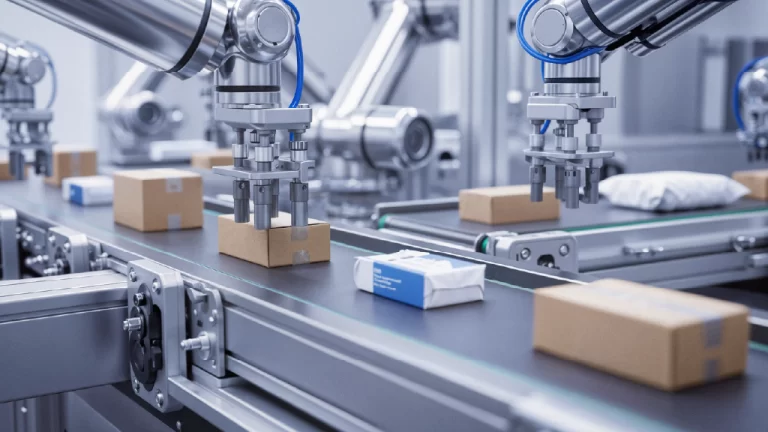Conveyor belts are essential across multiple industrial sectors: from mining and agriculture to logistics, manufacturing, and the food industry. Their main function is the continuous transport of materials or products from one point to another within a production process. What many people don’t know is that the core of a conveyor belt lies in its technical fabrics, high resistance materials that make safe, efficient, and long lasting performance possible.
In this article, we’ll explain what a conveyor belt is, how it works, and most importantly, which technical fabrics are used in its manufacturing. You’ll see why these fabrics are vital to guarantee the performance of conveyor systems in the most demanding environments.
What Is a Conveyor Belt?
A conveyor belt is a mechanical system used to continuously move materials from one place to another, usually in an automated way. It consists of a moving belt that slides over rollers or a flat structure, driven by electric motors.
These belts can transport almost anything: agricultural products like grains or fruit, heavy minerals, industrial parts, packages, processed foods, or construction materials. That’s why you’ll find them in factories, recycling plants, airports, distribution centers, mines, ports, and warehouses.
Main Components of a Conveyor Belt
A conveyor belt system is made up of several parts, but the most important are:
- The belt itself: the main component that carries the materials.
- Rollers:guide and support the belt.
- Motor:powers the movement.
- Frame or chassis:supports the entire system.
- Tensioning system:keeps proper belt tension for continuous operation.
The most critical component is undoubtedly the belt, as it is in direct contact with the materials and exposed to mechanical forces, friction, abrasion, weight, and often extreme chemical or thermal conditions. This is where technical fabrics play a key role.
What Are Technical Fabrics?
The technical fabrics are textile materials designed not for aesthetics but for specific mechanical, thermal, chemical, or structural functions. They are made from synthetic or natural fibers with special properties such as high tensile strength, durability, flexibility, resistance to heat, chemicals, or wear.
They are used in numerous industrial applications like airbags, bulletproof vests, geotextiles, sails, and of course, conveyor belts.
Which Technical Fabrics Are Used in Conveyor Belts?
The belt of a conveyor belt usually consists of several layers. At its core, you’ll find technical fabrics that provide strength and flexibility. These fabrics are then coated with rubber, PVC, PU, or silicone depending on the specific application.
Here are some of the most common technical fabrics used in conveyor belt manufacturing:
1. Polyester (PET)
Key characteristics:
- High tensile strength.
- Dimensional stability
- Good wear resistance
- Low elongation
Polyester is ideal for belts requiring high strength and minimal stretching along the longitudinal direction.
2. Nylon (PA)
Known for its excellent flexibility and fatigue resistance. It also offers:
- Good abrasion resistance
- High elasticity
- Strong impact absorption capacity
3. Polypropylene (PP)
Lightweight, moisture-resistant, and with strong chemical resistance, polypropylene is used in aggressive environments or where belts are exposed to chemicals.
4. Aramid
Used in applications requiring maximum strength and minimal elongation. Conveyor belts reinforced with aramid are ideal for extremely demanding conditions.
5. Fiberglass
Commonly found in conveyor belts designed for high-temperature environments, such as industrial ovens or dryers.
Why Are Technical Fabrics Important in a Conveyor Belt?
The technical fabrics determine a conveyor belt’s load capacity, flexibility, durability, and wear resistance. Choosing the right fabric means:
- Longer service life for the belt
- Less downtime for maintenance
- Greater efficiency in industrial processes
- Lower operating costs
For example, in a mining operation moving tons of rock daily, a low-quality belt may fail prematurely. On the other hand, a belt reinforced with specialized technicalfabrics will last significantly longer with less maintenance.
How to Choose the Right Technical Fabric
The choice of fabric depends on the type of load, the operating environment, and the system’s characteristics. Key factors include:
- Type of material transported:weight, abrasiveness, temperature.
- Length and speed of the belt.
- Environmental conditions:humidity, chemical exposure, temperature.
- Frequency of use and curves in the path.
The conveyor belt is a critical component of modern production chains. But its efficiency and durability depend largely on the technical fabrics inside. Materials such as polyester, nylon, polypropylene, or aramid allow these belts to withstand heavy loads, extreme conditions, and continuous cycles without failure.
At Textiles Omnes, we are committed to producing high-performance technical fabrics, adaptable to any type of conveyor belt. Our customization capabilities, wide range of weights, finishes, and weaves allow us to deliver robust, efficient, and durable solutions for every industry.
Innovation in technical fabrics for conveyor belts is constantly evolving, incorporating lighter, stronger, and more sustainable fibers. Today, it’s possible to manufacture belts with material combinations that not only withstand extreme conditions but also reduce energy consumption and minimize environmental impact. This means investing in a conveyor belt reinforced with next-generation fabrics not only improves productivity but also contributes to more responsible and efficient industrial processes.



